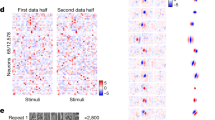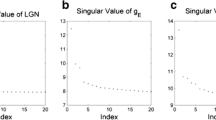Abstract
In this paper we show that the emergence of perceptual units in V1 can be explained in terms of a physical mechanism of simmetry breaking of the mean field neural equation. We consider a mean field neural model which takes into account the functional architecture of the visual cortex modeled as a group of rotations and translations equipped with a degenerate metric. The model generalizes well known results of Bressloff and Cowan which, in absence of input, accounts for hallucination patterns. The main result of our study consists in showing that in presence of a visual input, the stable eigenmodes of the linearized operator represent perceptual units of the visual stimulus. The result is strictly related to dimensionality reduction and clustering problems.




















Similar content being viewed by others
References
Amari, S. (1972). Characteristics of random nets of analog neuron-like elements. Systems Man Cybernet. SMC-2.
Angelucci, A., Levitt, J.B., Walton, E.J.S., Hupe, J.-M., Bullier, J., Lund, J.S. (2002). Circuits for loocal and global signal integration in primary visual cortex. The Journal of Neuroscience, 22 (19), 86338646.
August, J., & Zucker, S.W. (2000). The curve indicator random field: curve organization via edge correlation. In: Boyer, K., & Sarkar, S. (Eds.) In Perceptual organization for artificial vision systems. Kluwer, Norwell, (pp. 265–288).
August, J., & Zucker, S.W. (2003). Sketches with curvature: the curve indicator random field and Markov processes. IEEE Transaction Pattern Analysis and Machine Intelligence, 25 (4), 387–400.
Barbieri, D., Citti, G., Sanguinetti, G., Sarti, A. (2014). An uncertainty principle underlying the functional architecture of V1. Journal of Physiology Paris, 106 (5–6), 183–193.
Berry, M.V., & Dennis, M.R. (2000). Phase singularities in isotropic random waves. Proceedings of the Royal Society of London. Series A: Mathematical, Physical and Engineering Sciences 456(2001):20592079.
Blasdel, G.G. (1992). Orientation selectivity, preference, and continuity in monkey striate cortex. Journal of Neuroscience, 12, 3139–3161.
Bonhoeffer, T., & Grinvald, A. (1991). Iso-orientation domains in cat visual cortex are arranged in pinwheel-like patterns. Nature, 353 (6343), 429–431.
Boscain, U. , Duplaix, J. , Gauthier, J.P. , Rossi, F. (2012). Anthropomorphic image reconstruction via hypoelliptic diffusion. SIAM Journal of Control Optimazation, 50 (3), 1309–1336.
Bosking, W.H., Zhang, Y., Schofield, B., Fitzpatrick, D. (1997). Orientation selectivity the arrangement of horizontal connections in tree shrew striate cortex. Journal of Neuroscience, 17 (6), 2112–2127.
Bressloff, P.C., & Cowan, J.D. (2003). The functional geometry of local and long-range connections in a model of V1. Journal of Physiology Paris, 97 (2-3), 221–236.
Bressloff, P.C., Cowan, J.D., Golubitsky, M., Thomas, P.J., Wiener, M.C. (2002). What geometric visual hallucinations tell us about the visual cortex. Neural Computation, 14, 473–491.
Brezis, H. (2011). Functional analysis, Sobolev spaces and PDE. New York: Springer.
Chossat, P. , Faye, G. , Faugeras, O. (2011). Bifurcation of hyperbolic planforms. Journal of Nonlinear Science, 21, 465498.
Citti, G., & Sarti, A. (2006). A cortical based model of perceptual completion in the roto-translation space. Journal of Mathematical Imag Vis, 24 (3), 307–326.
Cocci, G., Barbieri, D., Citti, G., Sarti, A. (2014). Cortical spatio-temporal dimensionality reduction for visual grouping Accepted on Neural Computation.
Coifman, R., & Lafon, S. (2006). Geometric harmonics: A novel tool for multiscale out-of-sample extension of empirical functions. Applied and Computational Harmonic Analysis, 21 (1), 31–52.
Coifman, R.R. , Lafon, S. , Lee, A.B. , Maggioni, M. , Warner, F. , Zucker, S. (2005). Geometric diffusions as a tool for harmonic analysis and structure definition of data: Diffusion maps. Proceedings of the National Academy of Sciences, 102(21):7426–7431.
Daugman, J.G. Uncertainty relation for resolution in space, spatial frequency, and orientation optimized by two-dimensional visual cortical filters. Journal of the Optical Society of America A, 2 (7), 1160–1169.
Duits, R., & Franken, E.M. (2010a). Left invariant parabolic evolution equations on SE(2) and contour enhancement via invertible orientation scores, part I: Linear left-invariant diffusion equations on SE(2). Quarterly of Applied Mathematics, 68, 255–292.
Duits, R., & Franken, E.M. (2010b). Left invariant parabolic evolution equations on SE(2) and contour enhancement via invertible orientation scores, part II: Nonlinear left-invariant diffusion equations on invertible orientation scores. Quarterly of Applied Mathematics, 68, 293–331.
Duits, R., Führ, H., Janssen, B., Bruurmijn, M., Florack, L., Van Assen, H. (2011). Evolution equations on Gabor transforms and their applications . arXiv:http://arxiv.org/abs/1110.6087.
Durbin, R., & Mitchison, G. (1990). A dimension reduction framework for understanding cortical maps. Nature, 343, 644647.
Ermentrout, G.B., & Cowan, J.D. (1979). Temporal oscillations in neuronal nets. Journal of mathematical biology, 7 (3), 265–280.
Ermentrout, G.B., & Cowan, J.D. (1980). Large scale spatially organized activity in neural nets. SIAM. Journal of Applied Mathematics, 38 (1), 1–21.
Faugeras, O., Veltz, R., Grimbert, F. (2009). Persistent neural states: stationary localized activity patterns in nonlinear continuous n-population, q-dimensional neural networks. Neural Computation, 21, 147187.
Faye, G., & Faugeras, O. (2010). Some theoretical and numerical results for delayed neural field equations. Physica D, 239 (9), 561578.
Faugeras, D. (2012). Neural fields models of visual areas: principles, successes, and caveats. ECCV Workshops 1, 474–479.
Field, D.J., Hayes, A., Hess, R.F. (1993). Contour integration by the human visual system: evidence for a local association field. Vision Res, 33, 173–193.
Higham, D.J. (2001). An algorithmic introduction to numerical simulation of stochastic differential equations. SIAM Review, 43 (3), 525–546.
Hoffman, W.C. (1989). The visual cortex is a contact bundle. Applied Mathematics and Computation, 32, 137–167.
Hubel, D.H. (1988). Eye, Brain and Vision. New York: Scientific American Library.
Hubel, D.H., & Wiesel, T.N. (1977). Ferrier lecture: Functional architecture of macaque monkey visual cortex. Proceedings of the Royal Society of London Series B, 198 (1130), 1–59.
Kilpatrick, Z.P., & Bressloff, P.C. (2010). Effects of synaptic depression and adaptation on spatio temporal dynamics of an excitatory neuronal network. Physica D, 239, 547–560.
Koenderink, J.J., & van Doorn, A.J. (2008). The structure of visual space. Journal of mathematical imaging and vision, 31 (2–3), 171–187.
Montgomery, R. (2001). A tour of Subriemannian geometries, their geodesics and applications. AMS.
Merleau-Ponty, M. (2012). Phenomenology of perception. New York: Routledge.
Mumford, D. (1993). Elastica and computer vision. Algebraic Geometry and its Applications, 1993, 507–518.
Nagel, A. , Stein, E.M. , Wainger, S. (1985). Balls and metrics defined by vector fields I: Basic properties. Acta Mathematics, 155, 103147.
Perona, P., & Freeman, W.T. (1998). A factorization approach to grouping. In: Burkardt, H. , & Neu- mann, B. (Eds.) Proceedings ECCV, (pp. 655–670).
Petitot, J., & Tondut, Y. (1999). Vers une neurogéométrie. Fibrations corticales, structures de contact et contours subjectifs modaux. Mathematical Sciences Human, 145, 5–101.
Robert, C.P., & Casella, G. (2004). Monte Carlo statistical methods, 2nd Edition. New York: Springer.
Rothschild, L., & Stein, E. (1976). Hypoelliptic differential operators and nilpotent groups. Acta Mathematics, 137, 247–320.
Sachkov, Y. L. (2011). Cut locus and optimal synthesis in the sub-Riemannian problem on the group of motions of a plane. ESAIM: COCV, 17 (2), 293–321.
Sanguinetti, G., Citti, G., Sarti, A. (2008). Image completion using a diffusion driven mean curvature flowin A sub-riemannian space. VISAPP (2)’08, 46–53.
Sanguinetti, G., Citti, G., Sarti, A. (2010). A model of natural image edge co-occurrence in the rototranslation group. Journal of Visual, 10 (14).
Sarti, A., Citti, G., Petitot, J. (2008). The symplectic structure of the primary visual cortex. Biological Cybernetics, 98, 33–48.
Shi, J., & Malik, J. (1997). Normalized cuts and image segmentation. In: Proceedings IEEE Conf. Computer Vision and Pattern Recognition, (pp. 731–737).
Sugiura, M. (1976). Unitary representations and harmonic analysis: an introduction, North Holland Kodansha.
Turing, A.M. (1952). The chemical basis of morphogenesis, philosophical transactions of the royal society of London. Series B. Biological Sciences, 237 (641), 37–72.
Veltz, R., & Faugeras, O. (2011). Stability of the stationary solutions of neural field equations with propagation delays. The Journal of Mathematical Neuroscience (JMN).
Williams, L.R. (1995). Stochastic completion fields. ICCV Proceedings.
Wilson, H.R., & Cowan, J.D. (1972). Excitatory and inhibitory interactions in localized popula- tions of model neurons,. Biophysical Journal, 12, 1–24.
Wilson, H.R., & Cowan, J.D. (1973). A mathematical theory of the functional dynamics of cortical and thalamic nervous tissue. Biological Cybernetics, 13 (2), 55–80.
Weiss, Y. (1999). Segmentation using eigenvectors: a unifying view Computer Vision. The Proceedings of the Seventh IEEE International Conference.
Zucker, S.W. (2006). Differential geometry from the Frenet point of view: boundary detection, stereo, texture and color. In: Paragios, N., Chen, Y., Faugeras, O (Eds.) In Handbook of mathematical models in computer vision. Springer, US, (pp. 357–373).
Conflict of interests
The authors declare that they have no conflict of interest
Author information
Authors and Affiliations
Corresponding author
Additional information
Action Editor: Bard Ermentrout
Rights and permissions
About this article
Cite this article
Sarti, A., Citti, G. The constitution of visual perceptual units in the functional architecture of V1. J Comput Neurosci 38, 285–300 (2015). https://doi.org/10.1007/s10827-014-0540-6
Received:
Revised:
Accepted:
Published:
Issue Date:
DOI: https://doi.org/10.1007/s10827-014-0540-6




